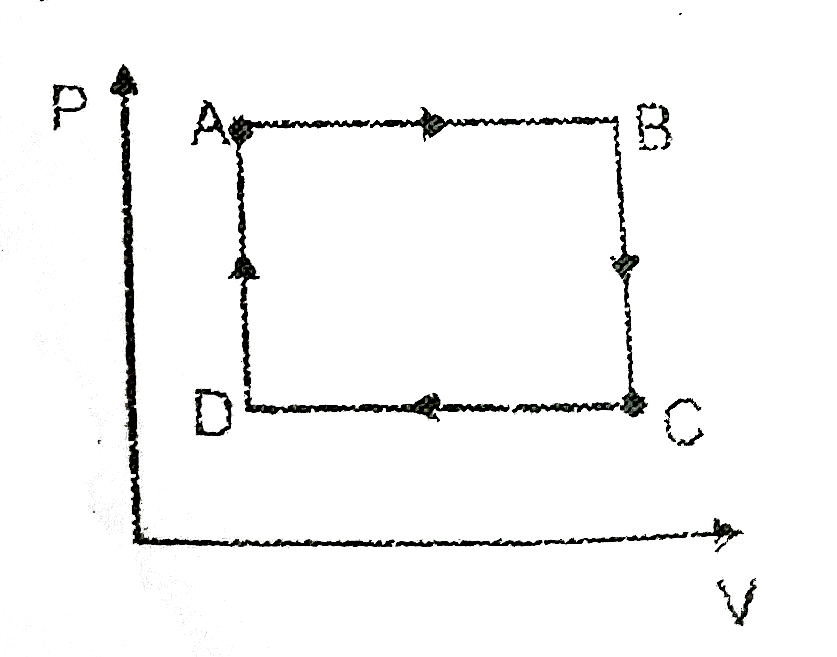If Q, E and W denote respectively the heat added, change in internal energy and the work done in a closed cycle process, then
W=0
Q=W=0
E=0
Q=0
The correct Answer is:C
To solve the problem, we need to analyze the concepts of heat (Q), internal energy change (E), and work done (W) in the context of a closed cyclic process.
1. Understanding Closed Cycle Process:
- In a closed cycle process, a system returns to its initial state after completing the cycle. This means that all the properties of the system, including internal energy, return to their original values.
2. Change in Internal Energy (E):
- The change in internal energy (E) for a closed cycle is given by the formula:
E=Ufinal−Uinitial
- Since the system returns to its initial state, we have:
Ufinal=Uinitial
- Therefore, the change in internal energy (E) is:
E=Uinitial−Uinitial=0
3. First Law of Thermodynamics:
- The first law of thermodynamics states:
Q=E+W
- Substituting the value of E into the equation, we get:
Q=0+W
- This simplifies to:
Q=W
4. Conclusion:
- In a closed cycle process, the heat added (Q) is equal to the work done (W), and the change in internal energy (E) is zero.
Final Result:
- For a closed cycle process, we conclude that:
E=0,Q=W
- In a closed cycle process, a system returns to its initial state after completing the cycle. This means that all the properties of the system, including internal energy, return to their original values.
- The change in internal energy (E) for a closed cycle is given by the formula:
E=Ufinal−Uinitial
- Since the system returns to its initial state, we have:
Ufinal=Uinitial
- Therefore, the change in internal energy (E) is:
E=Uinitial−Uinitial=0
- The first law of thermodynamics states:
Q=E+W
- Substituting the value of E into the equation, we get:
Q=0+W
- This simplifies to:
Q=W
- In a closed cycle process, the heat added (Q) is equal to the work done (W), and the change in internal energy (E) is zero.
- For a closed cycle process, we conclude that:
E=0,Q=W
Topper's Solved these Questions
- KINETIC THEORY OF GASES AND THERMODYNAMICSBook:A2ZChapter:KINETIC THEORY OF GASES AND THERMODYNAMICSExercise:AIIMS Questions
Explore 27 Videos
- KINETIC THEORY OF GASES AND THERMODYNAMICSBook:A2ZChapter:KINETIC THEORY OF GASES AND THERMODYNAMICSExercise:Chapter Test
Explore 29 Videos
- KINETIC THEORY OF GASES AND THERMODYNAMICSBook:A2ZChapter:KINETIC THEORY OF GASES AND THERMODYNAMICSExercise:Assertion Reasoning
Explore 15 Videos
- GRAVITATIONBook:A2ZChapter:GRAVITATIONExercise:Chapter Test
Explore 29 Videos
- MOCK TESTBook:A2ZChapter:MOCK TESTExercise:Motion With Constant Acceleration
Explore 15 Videos
Similar Questions
Knowledge Check
A sample of an ideal gas undergoes on isothermal expansion. If dQ, dU and dW represent the amount of heat supplied, the change in internal energy and the work done respectively,then
AdQ=+ve,dU=+ve,dW=+veBdQ=+ve,dU=0,dW=+veCdQ=+ve,dU=+ve,dW=0DdQ=−ve,dU=−ve,dW=−veIn an isothermal expansion change in internal energy and work done by the gas are respectively
A(-) ve, (-) veB0, (+) veC0, (-) veD(+) ve, (-) veIn an isothermal expansion change in internal energy and work done by the gas are respectively
A(-)ve, (-) yeB0, (+)veC0,(-)veD(+) ve, (-) ve
What is the change in internal energy when 4 Kj of work is done on the system and 1 Kj of heat is given out.
View SolutionLet Q and W denote the amount of heat given to an ideal gas the work done by it in an isothermal process.
View SolutionLet QandW denote the amount of heat given to an ideal gas the work done by it in an adiabatic process.
View SolutionIn given figure, let ΔU1 and ΔU2 be change in internal energy in process ABC and CDA respectively. ΔQ and W be the net heta given and net work done by the system in the process ABC+CDA, then

View SolutionIf ΔU and ΔW represent the increase in internal energy and work done by the system resectively in a thermodynamical process, which of the following is true?
View Solution

